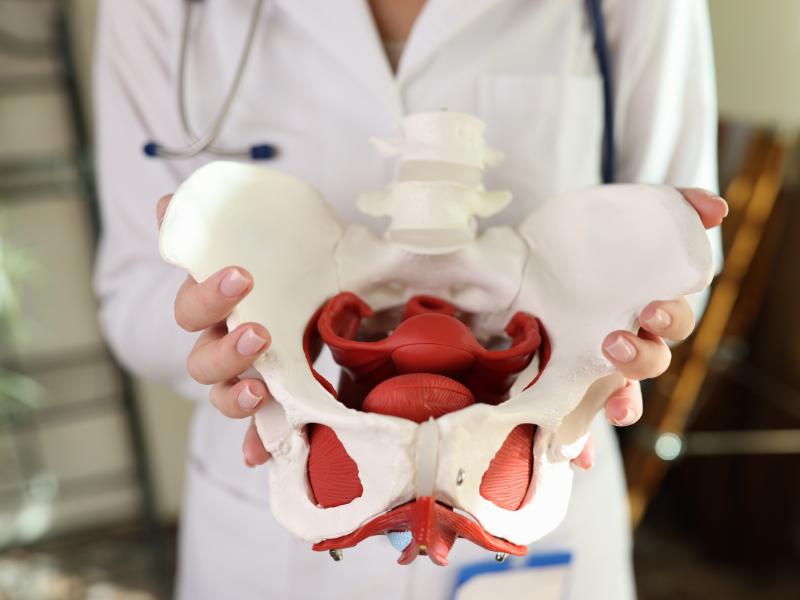
What is the Pelvic Floor?
The pelvic floor is a group of muscles that stretch like a supportive sling or hammock from the pubic bone at the front to the end of the spine at the back. These muscles hold up and support the uterus, bladder, and bowel, effectively keeping them in place and ensuring they function correctly.
What Happens to Your Pelvic Floor During Pregnancy?
During pregnancy, the pelvic floor muscles undergo significant strain due to the continual weight of your growing baby. This pressure can cause the muscles to stretch and weaken, making it more challenging for them to perform tasks such as preventing incontinence, supporting the pelvic organs, and aiding in sexual function. Childbirth can exacerbate these issues, often leading to conditions such as stress incontinence, a problem nearly a third of women experience post-delivery.
Some women find that the effects linger long after pregnancy, experiencing issues like bladder leaks when sneezing, laughing, coughing, or engaging in physical activities.
To give your pelvic floor muscles the best chance of performing well despite these stresses, it is recommended to regularly practice pelvic floor exercises, also known as Kegel exercises. These exercises, along with pelvic floor trainers if needed, can significantly help in maintaining the strength and function of these crucial muscles.
What are Pelvic Floor Exercises (Kegels)?
Pelvic floor exercises, or kegels, are simple exercises that help strengthen the pelvic floor muscles. These exercises are beneficial not only during and after pregnancy but also for improving overall pelvic health, sexual function, and preventing or treating issues like incontinence and prolapse for both men and women.
How to Do Pelvic Floor Exercises
Here’s a step-by-step guide on how to perform these exercises:
- Identify Your Pelvic Floor Muscles: A good way to locate these muscles is to imagine stopping the flow of urine midstream. The muscles you tighten to do this are your pelvic floor muscles. This should only be done as a means of identifying the muscles and not as a regular practice as it can harm the bladder.
- Basic Technique:
- Sit or lie down in a comfortable position.
- Tighten your pelvic floor muscles as if you are trying to stop urinating or prevent passing gas. Imagine drawing something up and into your vagina.
- Hold the contraction for a count of 10 seconds, then relax for another 10 seconds.
- Repeat this process five times.
- Progressive Muscle Training:
Once accustomed to basic exercises, try tightening and relaxing the muscles without holding, 10 to 15 times in succession.
Imagine the muscles as a lift, gradually tightening them floor by floor. - Breathing:
Ensure you’re breathing normally throughout the exercises.
Avoid tightening your legs, buttocks, or stomach—focus solely on the pelvic floor muscles.
As one Mumsnet user suggests, imagine holding in a bowel movement to help identify and engage the correct muscles. Build up to about 10 repetitions, tightening and holding in different positions throughout the day.
How Often Should You Exercise Your Pelvic Floor?
Ideally, do these exercises as often as possible since they can be done discreetly throughout the day during routine activities like watching TV or riding the bus. It is essential to balance tightening with relaxing the muscles to avoid over-tension.
When Will You See Results?
If done regularly, you should start to notice improvements within a few months. It’s vital to continue these exercises even after you notice the benefits to maintain a strong and healthy pelvic floor.
What If You Don’t Exercise Your Pelvic Floor?
Neglecting pelvic floor exercises can lead to various functional problems such as incontinence and prolapse, where pelvic organs drop into the vagina. This can cause symptoms like a dragging sensation in the pelvic area, discomfort during sex, and continence issues. A weak pelvic floor can also diminish sexual satisfaction and make orgasms more challenging to achieve.
Do Pelvic Floor Exercises Really Work?
Generally, yes—pelvic floor exercises are effective for most people. However, if you don’t notice improvements, consult your healthcare provider. Some may benefit from additional treatments like electrical stimulation, a procedure where a small probe introduces an electrical current to help strengthen the muscles. This method is available through the NHS and can also be purchased for home use.
In summary, maintaining a strong pelvic floor through regular exercise is crucial not only during pregnancy but for lifelong pelvic health and sexual well-being. Start incorporating these exercises into your daily routine for beneficial results.
Comments